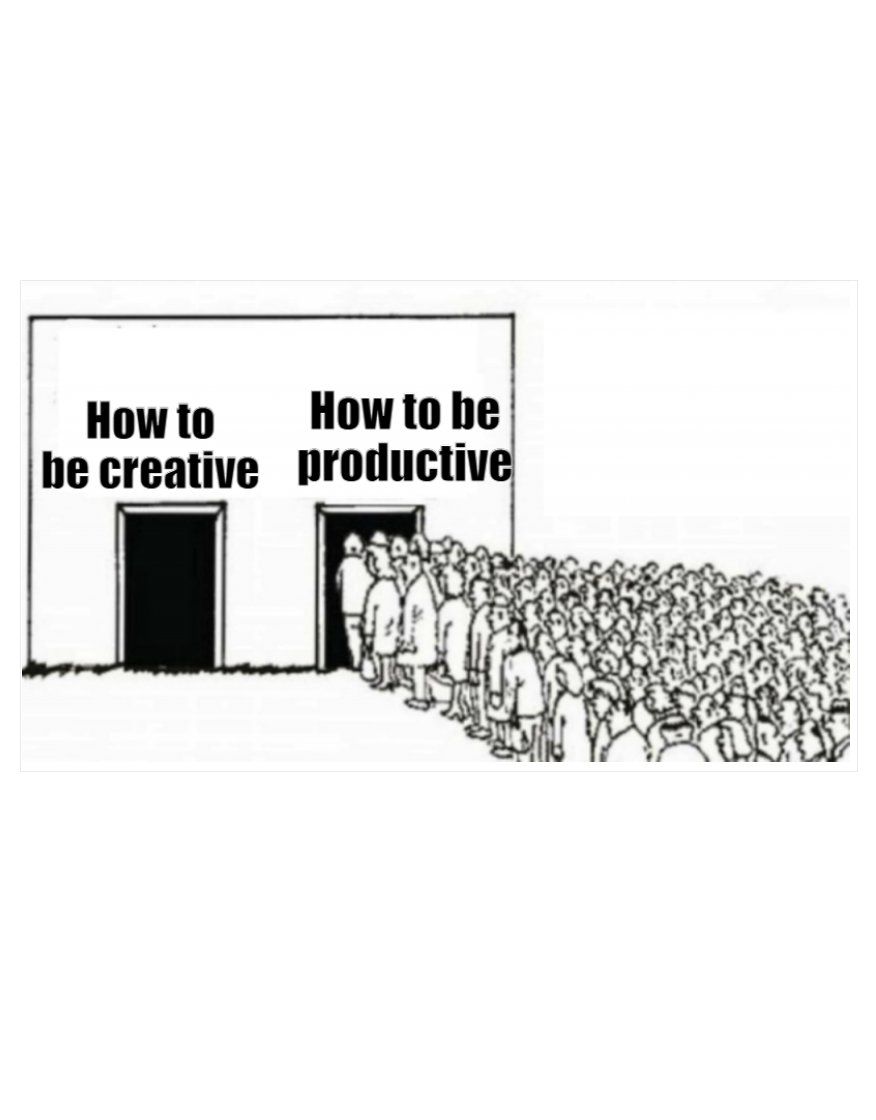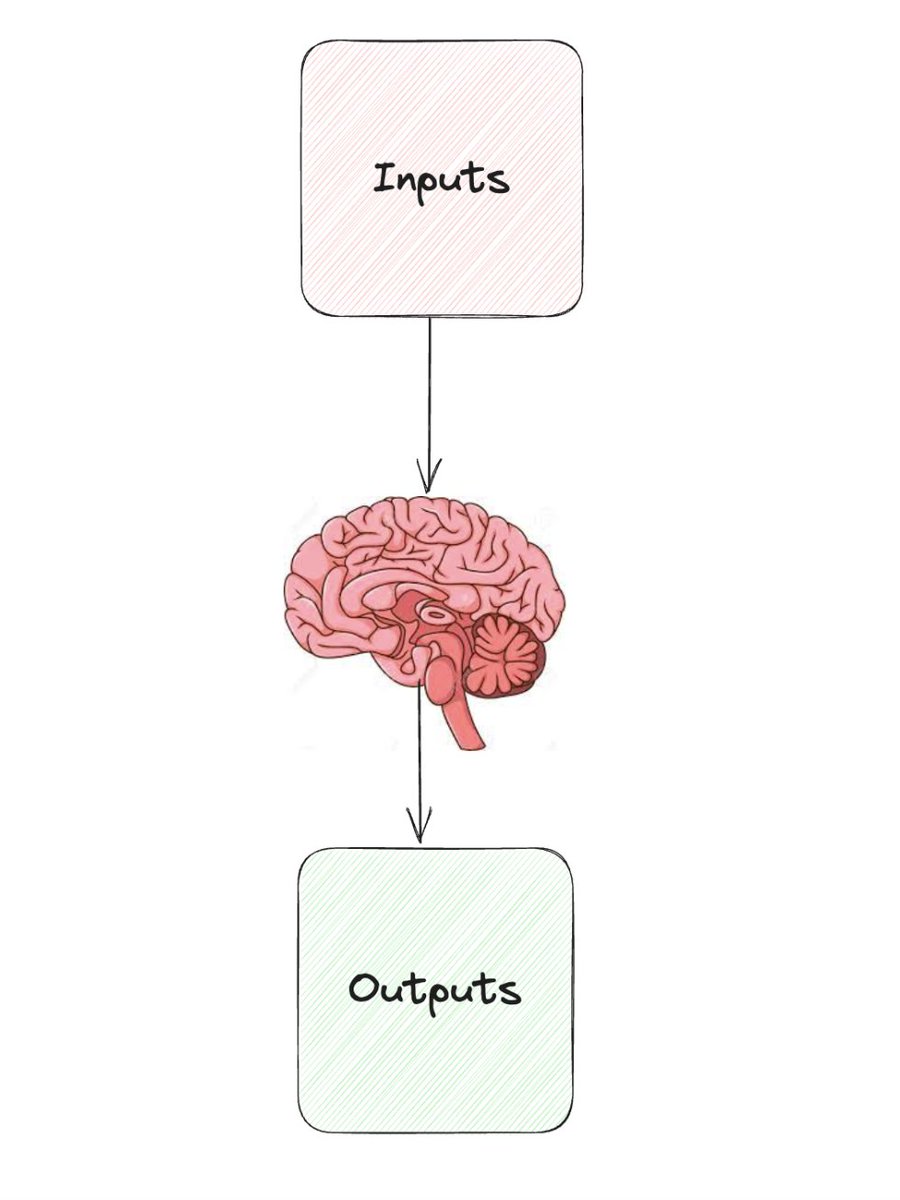
At a first principles level:
- The brain has inputs and outputs
- Creativity is an output that is both novel and useful
从基本原理的角度来看:
- 大脑有输入和输出
- 创意是一种既新颖又有用的输出

The mistake people make is treating creativity like productivity
We try to work harder and expect creativity to appear
Instead, add new inputs…
人们犯的错误是把创意当作生产力来对待
我们试图更加努力工作,并期望创意自然出现
相反,我们应该增加新的输入…

增加创造力的 11 个方式
1. The Swedish House Mafia Technique
Get a room with friends away from the outside world.
Throw ideas back and forth like a tennis rally.
Here’s Swedish House Mafia creating the iconic “One”. https://t.co/zZHXL3zVz7
- 瑞典浩室帮技巧
和朋友们找一个远离外界的房间。
像打网球一样来回抛出想法。
这里是瑞典浩室帮创作标志性作品”One”的过程。https://t.co/zZHXL3zVz7
2. Consume Niche Content
Go to YouTube or Twitter.
Step 1 - Scroll through explore page
Step 2 - Only click on content that has under 5K views
90% is often a waste of time.
But 10% turns into an incredible niche input that nobody else on the internet is tapping into.
That 10% input is like a VC’s investment portfolio - it makes up for all the failed investments
- 消费小众内容
去YouTube或Twitter。
第1步 - 浏览探索页面
第2步 - 只点击浏览量低于5000的内容
90%的内容通常是浪费时间。
但10%会变成互联网上其他人都没有接触到的令人难以置信的小众输入。
那10%的输入就像风险投资人的投资组合 - 它弥补了所有失败的投资
3. Balaji’s Transformer
If you have a written idea — try to draw it
If you have a visual idea — try to write it
If you have a numerical idea — try to explain it out loud
The process of transforming the idea from one language to another produces a new perspective
- Balaji的转换器
如果你有一个书面想法 — 试着把它画出来
如果你有一个视觉想法 — 试着把它写下来
如果你有一个数字想法 — 试着大声解释它
将想法从一种语言转换为另一种语言的过程会产生新的视角
E.g. Walt Disney’s business plan
Turning a dry 10,000-word business plan into an interconnected diagram opens up creative pathways.
例如,沃特·迪士尼的商业计划
将一个枯燥的10,000字商业计划转变为一个相互关联的图表,打开了创意的通道。

E.g. Christoper Nolan’s Plot for Inception
Turning the written script into a sketch opens up creative pathways
例如,克里斯托弗·诺兰的《盗梦空间》剧情
将书面剧本转变为草图,打开了创意的通道

4. Wake Up Early — Or Stay Up Late
Most people hit peak creativity whilst others are asleep.
Why?
The brain is free to stop worrying about other people — and fills the vacuum with ideas instead.
- 早起 — 或熬夜
大多数人在其他人睡觉时达到创意高峰。
为什么?
大脑可以自由地停止担心其他人 — 并用想法填补这个空白。
5. Create An Evil Twin
Imagine there’s an evil identical twin of you whose sole job is to out-think you.
What are they thinking?
This thought experiment allows the mind to explore creative ideas — because you can blame it on the twin.
- 创造一个邪恶的双胞胎
想象有一个你的邪恶双胞胎,他唯一的工作就是超越你的思考。
他们在想什么?
这个思维实验允许大脑探索创意想法 — 因为你可以把责任推给那个双胞胎。
6. Spin Wheels
-
Collect the best questions you find
-
Add them to a spinning wheel app
-
Spin the wheel before bed
-
Leave the question with the subconscious overnight
-
Brainstorm on the question first thing in the morning before any input https://t.co/b8Xx6ywLwK
-
旋转轮盘
-
收集你找到的最好的问题
-
把它们添加到一个旋转轮盘应用中
-
睡前转动轮盘
-
让问题在潜意识中过夜
-
早上第一件事就是在没有任何输入的情况下对这个问题进行头脑风暴 https://t.co/b8Xx6ywLwK
7. Study History
Most people only consume content made in the last 24 hours.
@david_perell calls this the “Never-Ending-Now”
If you study history, your inputs go from the best content in the last 24h to the best content ever made.
- 研究历史
大多数人只消费过去24小时内制作的内容。
@david_perell 称之为”永无止境的当下”
如果你研究历史,你的输入就从过去24小时内的最佳内容变成了有史以来最好的内容。
8. Be Like Japan
When I ask people where they want to travel to: Most say Japan
Japan practiced an isolationist policy called Sakoku for 265 years. They cut off the outside world — resulting in their unique culture
Once per quarter, practice Sakoku for a weekend or a week
- 像日本一样
当我问人们想去哪里旅行时:大多数人说日本
日本实行了一项名为”锁国”的闭关政策,持续了265年。他们切断了与外界的联系 — 结果形成了他们独特的文化
每季度实践一次”锁国”,持续一个周末或一周

Sakoku is intermittent fasting for the mimetic mind
In the interconnected age, your thoughts feel like your own — but it’s often society’s voice echoing.
When you spend a week alone with 0 external inputs — the echoes disappear and you hear your own creative voice
“锁国”是对模仿思维的间歇性禁食
在这个互联互通的时代,你的想法感觉像是你自己的 — 但它常常是社会声音的回响。
当你独自一人度过一周,没有任何外部输入时 — 回响消失了,你听到了自己创意的声音
9. Create A Mood Log
When you feel creative — log the causes.
When you feel uncreative — log the causes.
Once per month, review it and redesign your environment based on this log.
- 创建情绪日志
当你感到有创意时 — 记录原因。
当你感到没有创意时 — 记录原因。
每月回顾一次,并根据这个日志重新设计你的环境。

10. Julian’s Creativity Faucet
The incredible @Julian has this idea:
-
Visualize creativity as a backed-up pipe of water
-
The first mile is wastewater that needs to be emptied
-
After emptying the bad ideas, you begin to spot patterns as to why they are bad
Julian的创意水龙头
令人难以置信的@Julian有这样一个想法:
-
将创意想象成一个堵塞的水管
-
第一英里是需要排空的废水
-
排空坏主意后,你开始发现它们为什么不好的模式

Shapiro shows this great example of John Mayer applying the creativity faucet live in real-time.
Notice how he empties all the bad ideas — and the good ideas begin to click. https://t.co/M2tdI1mSyE
Shapiro展示了John Mayer实时应用创意水龙头的绝佳例子。
注意他是如何清空所有坏主意的 — 然后好主意开始涌现。https://t.co/M2tdI1mSyE
11. AirBnB’s 11* Thought Experiment
Ask people: “What would a 5* experience look like?”
When they answer this, surprise them by asking what 6* would look like.
Keep cranking it all the way up to 11*.
- 爱彼迎的11星思维实验
问人们:“5星级体验会是什么样的?”
当他们回答这个问题时,出其不意地问他们6星级会是什么样的。
继续把它一直提升到11星级。

12. Avoid Dramatic People
Human Brain Paradox: Your brain is a supercomputer — but it can only have 1 thought at a time.
Every thought has an opportunity cost.
Toxic and dramatic people are so dangerous to creativity — they eat your supercomputers RAM.
- 避开消极的人
人脑悖论:你的大脑是一台超级计算机 — 但它一次只能有一个想法。
每个想法都有机会成本。
有毒和戏剧化的人对创造力如此危险 — 他们会吞噬你超级计算机的内存。
13. Never Identify With Ideas
People don’t have ideas. Ideas have people.
You are just a vessel for ideas to pass through
- 永远不要与想法认同
人不拥有想法。想法拥有人。
你只是想法通过的载体